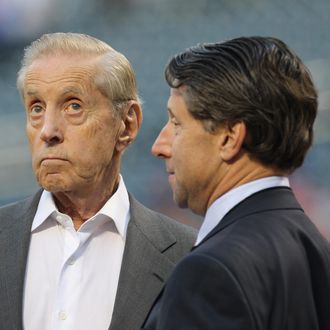
One of the things that’s made the Mets’ run to the World Series so remarkable is that they’ve done it while operating under the self-imposed payroll constraints that have kept them from spending like the big-market team they are. The Mets’ owners had hundreds of millions of dollars invested with Bernie Madoff before his Ponzi scheme collapsed, and in recent years the team’s finances have loomed over virtually everything the club has done. But could a run to the World Series change all that? To get a sense of the financial challenges still facing the team, earlier this week Daily Intelligencer emailed Howard Megdal, a journalist and author of the book Wilpon’s Folly, about whether they’re truly moving past Madoff, how much this World Series appearance might help, and whether they’ll be able to afford to bring back Yoenis Céspedes.
Fortune made the case recently that the Mets have moved on from the Madoff situation by making “savvy financial decisions, often galling but necessary.” Is that a fair narrative, or is it too optimistic?
So, that story missed the forest for the trees, I’m afraid. Mets spending hasn’t been affected by the Madoff suit very much, and not at all since the trustee for the Bernie Madoff victims, Irving Picard, agreed to a hardship settlement with them in March 2012 which guaranteed that they’d be personally liable for a maximum of $29 million. So that number coming down isn’t the issue. What’s limited team spending is the interest on the more than $700 million in debt against the team and SNY, the sports network Sterling (the parent company) owns 65 percent of, plus the twice-annual debt-balloon payments against the Citi Field bonds — that comes to roughly what the St. Louis Cardinals spend on payroll every year. So Mets ownership has needed to find that money first, and the team comes second.
It’s been noted that certain things outside of the team’s control (Jenrry Mejía’s suspension, David Wright’s insurance policy) helped free up some money mid-season. But looking ahead to the next couple of years, how hamstrung are they likely to be because of their finances? Is there any one thing in particular that worries you, or is it more a combination of factors?
Well, the thing to be concerned about is the debt didn’t go anywhere. It’s still there — the owners just refinanced and combined the $250 million due against the team in 2014 and the $600 million-plus due against the network in 2015, and tied them together in due date. And while Josh Kosman over at the Post reported the interest rate is “lower,” just how much lower is key. Few I’ve spoken to think it is much lower, especially if they didn’t pay down any of it. Since that’s been the issue hamstringing spending, the fact that it remains is a huge problem. Nor are the debt-balloon payments against the stadium going anywhere, either: They run until December 2045. So until the Mets owners prove they are capable of spending despite that annual debt financing, it is a concern.
A deep playoff run can mean millions of dollars the team wouldn’t have otherwise had. How far can that go toward putting them in a place where they can spend like a real big-market club? Or might it not even go toward payroll?
Well, that’s the huge question, which I wrote about last month: Fred Wilpon and Saul Katz made this incredible statement that never works — come to the park, and then we’ll spend money. Except, incredibly, it happened — the attendance went way up, and the Mets have tens of millions of dollars they didn’t have or had reason to believe they’d have on August 1. Then again, if you take it as the $45 million Kosman reports the Mets expect the extra revenue to be, well, that’s a couple of Citi Field bond payments. Will the Mets’ ownership use the extra money to give themselves a little financial breathing room? Pay down some debt? Or will they use the money on the team, as promised? Considering they’ve made similar promises for years, you’ll only know they are spending that money on the team once it actually happens.
But don’t mistake the extra money this year for the idea that the Mets/SNY were, in total, a money-losing operation. The Mets have the TV cash coming in everybody else in baseball does, and then some — they started cashing in earlier, thanks in part, again, to a big loan from Bernie Madoff. They’ve just been siphoning off that revenue since Madoff went bust to keep the parent company afloat, the kind of thing that should bother MLB but so far hasn’t.
Let’s say, for argument’s sake, that the Mets would like to bring back Yoenis Céspedes, and that money will be the deciding factor. Right now, how likely do you think it is that he’ll be a Met in 2016? Would the outcome of the World Series make a difference?
I think the extent to which the Mets have been noncommittal or worse on Céspedes publicly isn’t a great sign, nor is the team’s track record on large purchases since the day Bernie Madoff and their liquidity went poof in the night. Then again: Has anything Mets-related since the day Wilmer Flores wasn’t traded happened the way it used to? It’s why you’re seeing so many Wilpon stories right now. People are tired of it. I’m as tired of it as anyone. And it’s appealing to think everything has changed in Mets land. Too bad Daniel Murphy home runs don’t pay down debt. They just make Daniel Murphy more expensive.
Howard Megdal is a journalist and the author of the upcoming book The Cardinals Way.





























